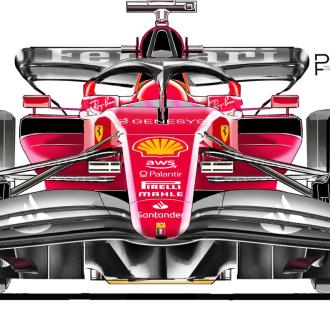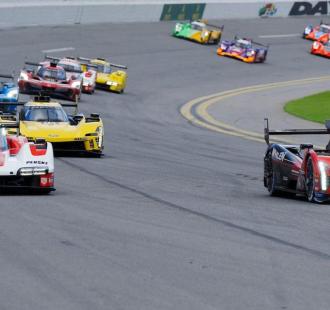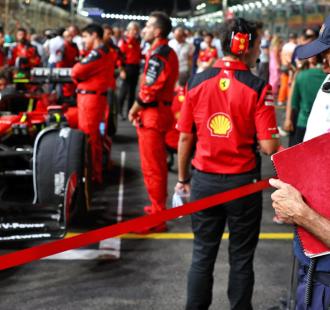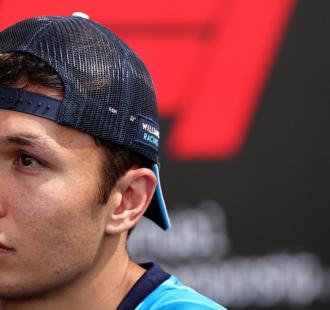
The secrets behind Ferrari's 2024 challenger lies in their understanding of the SF-23
When Ferrari put an end to Red Bull's dominant run of victories inSingapore, it was the result of gradually chipping away at theiradvantage with a clear development plan in 2023. The weaknesses ofthe SF-23 were already apparent during the pre-season tests inBahrain, prompting the Scuderia's engineers to opt for a change ofdirection of the aerodynamic concept. The engineers realised thestructural limitations of the project linked to the chassis, orrather, the position of the lateral crushable structures(anti-intrusion cones), radiators and electronic control units, andthe dimensions of the gearbox which had limited the diffuserdesign. Led by Enrico Cardile under the supervision of Diego Tondi,the objective of the aerodynamic engineers was to obtain a morestable dynamic and aerodynamic balance, and for a drastic reductionin tyre degradation. These exposed the underlying inconsistency ofthe car's performance in the race, compared to the performanceshown in qualifying. Exposing the underlying weaknesses Thisobjective was only achieved in the final part of the season at theDutch Grand Prix. This represented the turning point inunderstanding the dynamic and aerodynamic behaviour of the SF-23,and led to both Carlos Sainz and Charles Leclerc getting as closeas anyone to ending Red Bull's win streak at the following race inItaly. From that moment, in defining the setup for each grand prix,it was decided to sacrifice the maximum downforce and opting for abetter aerodynamic balance, with the adoption of particularly lowride heights. The floor of the car has progressively constituted apreview of the concepts integral to the 2024 single-seater. Asdescribed, even the lower part of the SF-23 was strongly limited bythe architecture, by the packaging of the accessories. As aconsequence, this prevented the development of sections of theVenturi channels, but above all the increase in the effectivenessof the diffuser which would have allowed greater downforce valuesto be obtained. This enabled greater stability in the high speedcorners, something that both drivers complained about as being'peaky' during the season. Defining a concept By mid-December thefirst chassis of the new single-seater had already been built andall the components were being assembled - ahead of a very tightschedule. There are two directions followed by aerodynamicists indefining the new car concept; one concerns the increase in the flowrate and quality of the air flow that touches the lower section ofthe sidepods. The increase in the section of the channel thatdevelops between the floor and the sidepods is essential to bring agreater flow and quality towards the rear. As described, last yearthe structural limit that prevented the realization of a similarconcept was the presence of lateral anti-intrusion cones halfway upthe chassis. For this reason the chassis in the 676 project hasbeen completely redesigned, not only by placing these elements atthe lower limit of the chassis, but also by repositioning theradiators and adopting a more advanced position on the sidepodscompared to the 2023 for electronics control units. The secondintervention, no less important nor less radical, concerns thetotal redesign of the gearbox to gain approximately 40mm in widthwith a redesigned pull rod rear axle. The central section of thefloor, which extends to the center of the diffuser on the 676, willbe decidedly narrower. This frees airflow in favour of an increasenot only in the effectiveness of its extraction, but also in theefficiency of the rear wing - specifically at the lower profilelevel (beam wing). Exploiting the low ride heights Last but notleast, as mentioned above, the intervention linked to the geometryof the suspension. Rumours over the course of last season pointedto the 2024 Ferrari suspension being similar to that of Red Bull,i.e. adopting the front pull rod and rear push rod scheme. Inreality the layouts will remain those of the SF-23, but thegeometries, i.e. the relative positioning of the various elements,will be different. Specifically, at the front suspension, the uppertriangle will be characterised by a strong inclination of the arms,thus guaranteeing an accentuated anti-dive (anti-sinking) effect onthe front end. The high inclination of the arms of the uppertriangle will have an aerodynamic value by increasing the down wash(downward deviation) of the air flow directed towards the channelbetween the sidepods and the floor. These features were taken tothe extreme on the world champion RB19, constituting a focal pointfor the management and reduction of longitudinal downforcetransfers. Above all, the revision of the rear suspension isconsidered fundamental for the competitiveness of the newsingle-seater. The (logical) choice of traveling with reduced rideheights, can be effective only on condition that porpoising ismarginal. The 'bottoming' effect that is generated by the sinkingof the rear axle in a straight line at full speed, can cause astrong, non-linear increase in the aerodynamic load - the maincause of aero-elastic jolts (porpoising). Given this assumption,the engineers directed by Cardile worked hard on redefining therear suspension and the floor attachments of the 676. Thiseliminated the bumps induced at an aerodynamic level and therefore,in theory thus allowing the constant adoption of a set-up on everytype of track close to the ground. In addition, despite beingfrozen in performance development, the power unit will adopt modes.Partially already implemented in the second part of 2023, thesewill feature less abrupt delivery of electric power duringacceleration to the further reduce tyre degradation. Clutchmanagement strategies, specifically in the starting phase, will beadapted more effectively to this parameter than in 2023. In short,Vasseur did not want to define the 2024 single-seater asrevolutionary, but it is undeniable that the cut with the recentpast will be clear. Project 676 in detail Front View Note thereduced lower section of the sidepods, especially in the lowersection with the anti-intrusion cones incorporated at the level ofthefloor. Highlighted in detail, the high inclination of the uppersuspension triangle to accentuate the ANTI DIVE effect. A furtherfeature will concern the minimum vertical cross section of thecooling air intakes which could have a decidedly Red Bull-inspiredprofile, or keep a more elongated section. SF-23 side view At itsdebut, the SF-23 was characterized by long sidepods with aconcave/tub upper profile. This determined a clear separationbetween the flow that lapped above them extracting the heat fromthe vertical slits arranged in an S configuration and the flowpassing between the lower profile of the sidepods and the floor.SF-23 development Austria In Austria, after the introduction inSpain of the new configuration with sloping sides, the engineersdirected by Tondi had tried to increase the width of the channelbetween the sidepods and the floor, clashing with theinsurmountable limit represented by the anti-intrusion cones (seedetail). SF-23 setup with reduced ride heights in the final phaseof the season In the last part of the season, the SF-23 adoptedminimum ride heights even on non-permanent tracks as in the case ofSingapore and Las Vegas, where the common tendency among the otherteams was to increase them. It was sign of the improved balance ofthe car, which has become less prone to aero-elastic jolts(porpoising).


